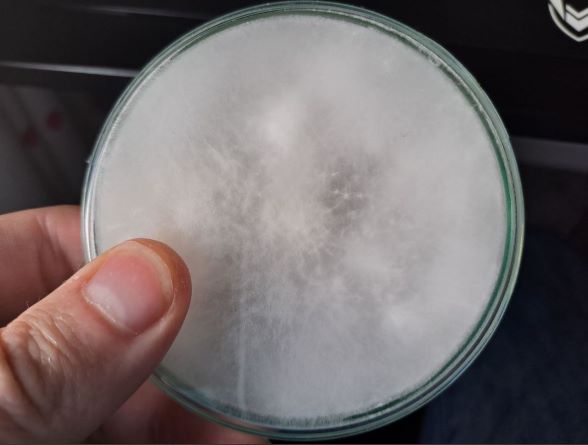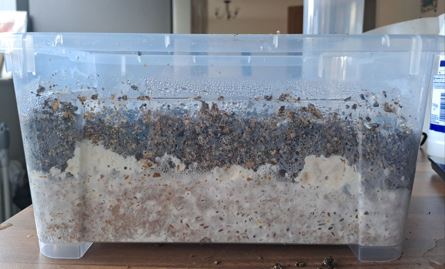
How To Grow Mushrooms At Home
Welcome to EZMushroom the starting point of your mycological education!
Here, we've gathered our collective knowledge and expertise to guide you through the fascinating process of mushroom cultivation. Whether you're a novice or looking to refine your techniques, this is where your journey to bountiful mushroom harvests begins.
We have created a range of tutorials on how to grow mushrooms at home, our main focus is for beginners wanting to grow gourmet mushrooms.

Introduction to Mushroom Cultivation.
Mushroom cultivation is the process of growing fungi under controlled conditions. Unlike plants, mushrooms do not require sunlight to grow. Instead, they obtain nutrients from organic material, such as wood, straw, or compost. By replicating the ideal conditions for mushroom growth, you can cultivate a variety of species right at home.
Below is a brief overview of the overall growing process which has been designed to acquaint you with the process without overwhelming you.
Understanding Mycelium.
At the heart of mushroom cultivation lies the mycelium, a network of thread-like cells that form the living body of a fungus. Think of mycelium as the roots of your mushrooms, though they are much more than that. This white, cobweb-like structure spreads through a nutrient-rich substrate, secreting enzymes that break down organic matter, which the fungus then absorbs as food. Mycelium is the unseen yet vital component of mushroom growth, and its health is paramount to successful cultivation.
The mushroom is the reproductive organ of the mycelium network and its final job is to release spores to restart the lifecycle.
The Role of Grain Spawn.
Grain spawn acts as the seeds for your mushrooms. Is essentially sterilized cereal grains such as rye, wheat, or millet—that has been inoculated (injected) with mushroom spores or mycelium. The grain provides a nutritious environment for the mycelium to colonize, grow and build a strong network with an immune system!
Once fully colonized, it’s ready to be transferred to a bulk substrate. The quality of your grain spawn is crucial and ensuring there is no contamination present before adding it to bulk is imperative.
Contamination can affect the speed of colonization and the overall yield of your mushroom crop potentially ruining the whole grow.
Bulk Substrate: The Fruiting Surface.
The bulk substrate is akin to the soil in which you plant a seed. It’s the material that your grain spawn will be mixed with to produce mushrooms. This substrate needs to be rich in nutrients and capable of retaining moisture, as both are necessary for robust mycelium growth. Common substrates include straw, hardwood sawdust, coco coir, or manure, depending on the mushroom species you intend to grow.
The substrate often requires pasteurization or sterilization to eliminate any unwanted bacteria or mold spores that could compete with the mycelium.
My favorite technique is the following one, where we can make and pasteurize sawdust blocks at home without a huge amount of equipment.
The Cultivation Process: Bringing It All Together.
Mushroom cultivation is a delicate process between maintaining the right conditions and avoiding contamination.
Here’s a simplified overview of how the process comes together:
Spawn Preparation: The journey begins with hydrating and sterilizing grain spawn to use as the first jumping off point for your mycelium to grow.
Inoculation: Next we begin inoculating your grain spawn with mushroom spores or mycelium. This is done in a sterile environment to prevent contamination.
Colonization: Once inoculated, the grain spawn is kept at the correct temperature and humidity to allow the mycelium to colonize the grain fully. This stage is critical and requires patience as the mycelium takes over the grain.
Substrate Preparation: When the grain spawn has finished colonizing, you prepare your bulk substrate, ensuring it’s properly pasteurized to make it a suitable home for the mycelium.
Spawning to Bulk: After the grain spawn is fully colonized, it’s mixed with the bulk substrate. This mix is often placed into containers or bags where the mycelium can continue to grow and spread through the new material.
Fruiting: With the right conditions—specific humidity, temperature, fresh air exchange, and sometimes light—the mycelium will produce pinheads, which are the beginnings of mushroom fruit bodies. These will develop into the mushrooms that are eventually harvested.
Harvest: Once the mushrooms have maturely grown, they’re ready to be harvested. The timing of the harvest is crucial to get the best flavor and texture from your mushrooms.
Post-Harvest: After harvesting, many mushroom species allow for multiple fruiting flushes. The substrate can often be rehydrated or rested before encouraging a new round of growth.
Guides & Tutorials
The foundation of mushroom cultivation begins with preparing your spawn. I have collated a list of tutorials on preparing different grains below:
- Rye / Wheat Grain Spawn.
- Pop Corn Grain Spawn.
- Millet Grain Spawn.
- PF-Tek.
- No Soak, No Simmer Grain Tek.
A guide which discusses methods for inoculating:
Once the grain spawn colonizes, prepare the bulk substrate. This nutrient-rich material must be pasteurized or sterilized. Un-supplemented substrate can be pasteurized whereas supplemented substrate (adding nutrients like coffee,bran,soy hulls) should be sterilized.
- An overview of Bulk Substrates.
- How to Pasteurize Bulk Substrate.
- Coco Coir (CVG) Substrate Recipe
- Making and Pasteurizing Sawdust Blocks at Home.
After preparation is complete and you have fully colonized grain spawn its time to “spawn to bulk”, which basically means mixing the grain spawn into the bulk substrate.
You can learn about that below:
With the right conditions—specific humidity, temperature and fresh air exchange—the mycelium will produce pinheads, which are the beginnings of mushroom fruit bodies. These will develop into the mushrooms that are eventually harvested.
Often fruiting is done in a range of ways dependent on the species which is being grown below is a list of fruiting chamber posts which should help you understand this:
Monotubs: These are often used to grow mushrooms which can tolerate high Co2 levels, mostly King Oysters and Reishi.
Shotgun Fruiting Chambers (SGFC): A popular choice for home cultivators. SGFCs are designed with numerous holes to facilitate fresh air exchange and a high humidity environment, which is crucial for the development of many mushroom species.
Martha Tents: These are essentially miniature greenhouses, which provide a controlled environment for a variety of mushrooms that require ample ventilation and consistent humidity. They are versatile and can be adjusted for the needs of different mushroom species.
Jars: Often used for smaller scale or personal cultivation, jars provide a controlled, contained environment for mycelium to fruit.
Buckets: Buckets are a simple and effective method for cultivating varieties like Oyster mushrooms. They allow for easy stacking and vertical farming, and with the right substrate and moisture conditions, they can be an excellent low-cost option for home growers but require an outdoor environment.
ShoeBox Tek: Discover the efficient Shoebox Tek method for mushroom cultivation in our comprehensive guide.
Trouble Fruiting? If you are having trouble maintaining fruiting conditions indoors learn to apply a casing layer to your improve surface fruiting conditions.
Liquid Culture is used in growing mushrooms to jump-start the mycelium growth in nutrient broth and speed up the process of creating grain spawn.
Often vendors will sell liquid culture mycelium which cultivators can grow mushrooms from. Below are guides relating to creating and using liquid culture in mycology.
- How To Make Liquid Culture For Mushroom Cultivation. – This is an overview of the whole process of making liquid cultive.
- Light Malt Extract Liquid Culture (LME) Recipe.
- How To Make Honey Liquid Culture.
- How To Make Karo Liquid Culture.
- How To Use Liquid Culture.
- Liquid Culture Vs Spore Syringe.
- Making Liquid Culture Using Agar.
Agar is a gelatinous substance used in mycology to cultivate mushroom mycelium, often it is used to test and ensure sterility of cultures before expansion. It provides a solid platform for spores to germinate and develop into a pure culture before transferring to grain spawn.
Many suppliers offer pre-poured agar plates that are ready for inoculation. Below, you’ll find guides on preparing, inoculating, and utilizing your own agar to advance your mycological endeavors. Agar can seem daunting at first but it is definitely worth mastering, I use it more than liquid culture as it produces consistent results.
Our collection of guides focuses on how to handle and germinate spores effectively, ensuring successful mushroom cultivation from the ground up. Whether you’re working with spore prints or syringes, we provide the know-how to get your grow underway.
Spore are not often utilized in gourmet mushroom cultivation unless you don’t have access to a liquid culture vendor OR you are doing more advanced stuff like breeding.
Here is a collection of guides related to Spores:









